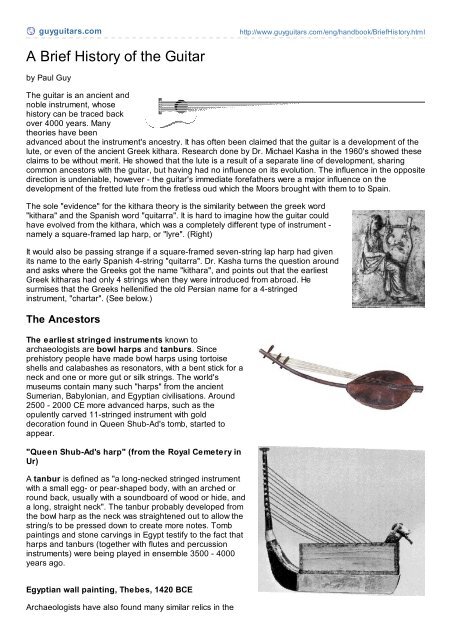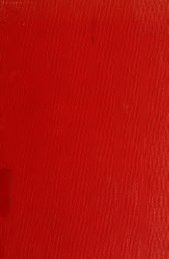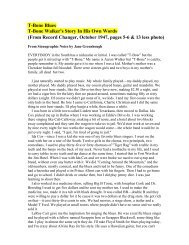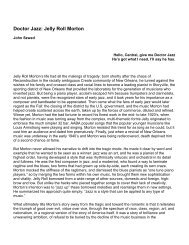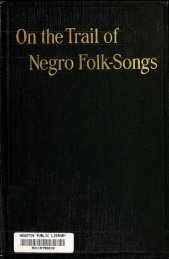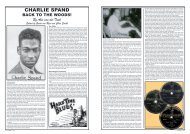Create successful ePaper yourself
Turn your PDF publications into a flip-book with our unique Google optimized e-Paper software.
guyguitars.comhttp://www.guyguitars.com/eng/handbook/<strong>Brief</strong><strong>History</strong>.htmlA <strong>Brief</strong> <strong>History</strong> <strong>of</strong> <strong>the</strong> <strong>Guitar</strong>by Paul GuyThe guitar is an ancient andnoble instrument, whosehistory can be traced backover 4000 years. Many<strong>the</strong>ories have beenadvanced about <strong>the</strong> instrument's ancestry. It has <strong>of</strong>ten been claimed that <strong>the</strong> guitar is a development <strong>of</strong> <strong>the</strong>lute, or even <strong>of</strong> <strong>the</strong> ancient Greek kithara. Research done by Dr. Michael Kasha in <strong>the</strong> 1960's showed <strong>the</strong>seclaims to be without merit. He showed that <strong>the</strong> lute is a result <strong>of</strong> a separate line <strong>of</strong> development, sharingcommon ancestors with <strong>the</strong> guitar, but having had no influence on its evolution. The influence in <strong>the</strong> oppositedirection is undeniable, however - <strong>the</strong> guitar's immediate forefa<strong>the</strong>rs were a major influence on <strong>the</strong>development <strong>of</strong> <strong>the</strong> fretted lute from <strong>the</strong> fretless oud which <strong>the</strong> Moors brought with <strong>the</strong>m to to Spain.The sole "evidence" for <strong>the</strong> kithara <strong>the</strong>ory is <strong>the</strong> similarity between <strong>the</strong> greek word"kithara" and <strong>the</strong> Spanish word "quitarra". It is hard to imagine how <strong>the</strong> guitar couldhave evolved from <strong>the</strong> kithara, which was a completely different type <strong>of</strong> instrument -namely a square-framed lap harp, or "lyre". (Right)It would also be passing strange if a square-framed seven-string lap harp had givenits name to <strong>the</strong> early Spanish 4-string "quitarra". Dr. Kasha turns <strong>the</strong> question aroundand asks where <strong>the</strong> Greeks got <strong>the</strong> name "kithara", and points out that <strong>the</strong> earliestGreek kitharas had only 4 strings when <strong>the</strong>y were introduced from abroad. Hesurmises that <strong>the</strong> Greeks hellenified <strong>the</strong> old Persian name for a 4-stringedinstrument, "chartar". (See below.)The AncestorsThe earliest stringed instruments known toarchaeologists are bowl harps and tanburs. Sinceprehistory people have made bowl harps using tortoiseshells and calabashes as resonators, with a bent stick for aneck and one or more gut or silk strings. The world'smuseums contain many such "harps" from <strong>the</strong> ancientSumerian, Babylonian, and Egyptian civilisations. Around2500 - 2000 CE more advanced harps, such as <strong>the</strong>opulently carved 11-stringed instrument with golddecoration found in Queen Shub-Ad's tomb, started toappear."Queen Shub-Ad's harp" (from <strong>the</strong> Royal Cemetery inUr)A tanbur is defined as "a long-necked stringed instrumentwith a small egg- or pear-shaped body, with an arched orround back, usually with a soundboard <strong>of</strong> wood or hide, anda long, straight neck". The tanbur probably developed from<strong>the</strong> bowl harp as <strong>the</strong> neck was straightened out to allow <strong>the</strong>string/s to be pressed down to create more notes. Tombpaintings and stone carvings in Egypt testify to <strong>the</strong> fact thatharps and tanburs (toge<strong>the</strong>r with flutes and percussioninstruments) were being played in ensemble 3500 - 4000years ago.Egyptian wall painting, Thebes, 1420 BCEArchaeologists have also found many similar relics in <strong>the</strong>
uins <strong>of</strong> <strong>the</strong> ancient Persianand Mesopotamian cultures.Many <strong>of</strong> <strong>the</strong>se instrumentshave survived into moderntimes in almost unchangedform, as witness <strong>the</strong> folkinstruments <strong>of</strong> <strong>the</strong> region like<strong>the</strong> Turkish saz, Balkantamburitsa, Iranian setar,Afghan panchtar and Greekbouzouki.The oldestpreserved guitar-likeinstrumentAt 3500 years old, this is <strong>the</strong>ultimate vintage guitar! Itbelonged to <strong>the</strong> Egyptiansinger Har-Mose. He wasburied with his tanbur closeto <strong>the</strong> tomb <strong>of</strong> his employer, Sen-Mut, architect to Queen Hatshepsut, who wascrowned in 1503 BCE. Sen-Mut (who, it is suspected, was far more than just chiefminister and architect to <strong>the</strong> queen) built Hatshepsuts beautiful mortuary temple, whichstands on <strong>the</strong> banks <strong>of</strong> <strong>the</strong> Nile to this day.Har-Moses instrument had three strings and a plectrum suspended from <strong>the</strong> neck by acord. The soundbox was made <strong>of</strong> beautifully polished cedarwood and had a rawhide"soundboard". It can be seen today at <strong>the</strong> Archaeological Museum in Cairo.Queen HatshepsutWhat is a guitar, anyway?To distinguish guitars from o<strong>the</strong>r members <strong>of</strong> <strong>the</strong> tanbur family, we need to define whata guitar is. Dr. Kasha defines a guitar as having "a long, fretted neck, flat woodensoundboard, ribs, and a flat back, most <strong>of</strong>ten with incurved sides" .The oldest known iconographical representation <strong>of</strong> an instrument displaying all <strong>the</strong>essential features <strong>of</strong> a guitar is a stone carving at Alaca Huyuk in Turkey, <strong>of</strong> a 3300year old Hittite "guitar" with "a long fretted neck, flat top, probably flat back, and withstrikingly incurved sides".The Lute (Al'ud, Oud)The Moors brought <strong>the</strong> oud to Spain. The tanbur hadtaken ano<strong>the</strong>r line <strong>of</strong> development in <strong>the</strong> Arabiancountries, changing in its proportions and remainingfretless.The Europeans added frets to <strong>the</strong> oud and called it a"lute" - this derives from <strong>the</strong> Arabic "Al'ud" (literally "<strong>the</strong>wood"), via <strong>the</strong> Spanish name "laud".A lute or oud is defined as a "short-necked instrumentwith many strings, a large pear-shaped body with highlyvaulted back, and an elaborate, sharply angledpeghead".Renaissance lute by Arthur RobbClick on <strong>the</strong> picture to go to Art's website.Beautiful instruments!


